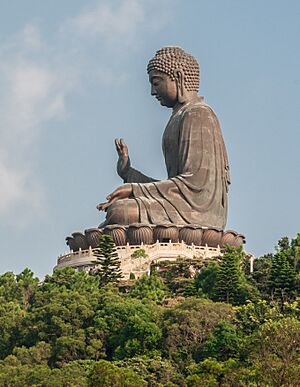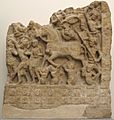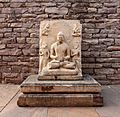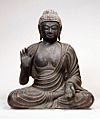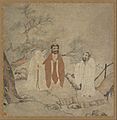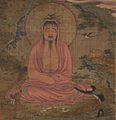Buddha facts for kids
|
Basic terms |
|
|
People |
|
|
Schools |
|
|
Practices |
|
|
study Dharma |
|
A Buddha is a very special and wise teacher in Buddhism. The word Buddha means "enlightened one" or "fully awakened one." It comes from ancient languages like Sanskrit and Pāli.
Sometimes, "the Buddha" refers to Siddhartha Gautama. He was the person who started Buddhism. People also call him "Shakyamuni Buddha." But the title "Buddha" can also mean anyone who has found enlightenment. If someone is very close to becoming a Buddha, they are called a bodhisattva.
Contents
What is a Buddha?
Buddhists believe there have been many Buddhas throughout history. The most recent famous one was Gautama Buddha. People who are on their way to becoming Buddhas are known as "bodhisattvas."
Buddhists believe that a Buddha is enlightened. This means they understand how to live a peaceful life. They know how to avoid suffering. It is said that a Buddha never argues. They only speak what is true and helpful. They do this out of kindness for everyone.
Some Buddhists pray to Buddhas. But Buddhas are not gods. Buddhas are like guides or teachers. They help people who are ready to listen. A Buddha is a human being who has "woken up." They see the world as it truly is. This special knowledge changes them completely. It helps them live a better life now and in the future. A Buddha can also help others find enlightenment.
There are special ideas that lead someone to enlightenment. These ideas are called the Dharma (in Sanskrit) or "Dhamma" (in Pāli). These words mean "the way" or "the truth." Anyone can become a Buddha, but it is very hard work. Gautama Buddha became enlightened under a peepal tree. This tree is now called the "bodhi" tree. It is in Bodhgaya, in what is now India.
Different Kinds of Buddhas
There are different types of Buddhas. One type is called a pratyekabuddha. These are also known as "silent Buddhas." These Buddhas reach enlightenment on their own. However, they do not teach others.
Another type is a samyaksambuddha. This is considered the best kind of Buddha. This is because they can teach all living beings. They share their wisdom with everyone.
Famous Buddhas from the Past
Buddhists believe that many Buddhas have lived in the past. They also believe many more will come in the future. Traditionally, seven Buddhas from the past are often named:
- Vipashyin Buddha
- Shikhin Buddha
- Vishvabhu Buddha
- Krakucchanda Buddha
- Kanakamuni Buddha
- Kashyapa Buddha
- Shakyamuni Buddha
The next Buddha to come will be named Maitreya.
What Makes a Buddha Special?
A Buddha is seen as a perfect person. Some traditions mention 32 special physical features of a Buddha. These features come from old stories. They are sometimes shown in art and statues. These marks show how special a Buddha is.
Related pages
Images for kids
-
Seated Buddha from Tapa Shotor monastery in Hadda, Afghanistan, 2nd century CE
-
Inscription "The illumination of the Blessed Sakamuni" (Brahmi script: 𑀪𑀕𑀯𑀢𑁄 𑀲𑀓𑀫𑀼𑀦𑀺𑀦𑁄 𑀩𑁄𑀥𑁄, Bhagavato Sakamunino Bodho) on a relief showing the "empty" Illumination Throne of the Buddha in the early Mahabodhi Temple at Bodh Gaya. Bharhut, c. 100 BCE.
-
One of the earliest anthropomorphic representations of the Buddha, here surrounded by Brahma (left) and Śakra (right). Bimaran Casket, mid-1st century CE, British Museum.
-
The "Great Departure" of Siddhartha Gautama, surrounded by a halo, he is accompanied by numerous guards and devata who have come to pay homage; Gandhara, Kushan period
-
The gilded "Emaciated Buddha statue" in Wat Suthat in Bangkok representing the stage of his asceticism
-
The Mahabodhi Tree at the Sri Mahabodhi Temple in Bodh Gaya
-
The Enlightenment Throne of the Buddha at Bodh Gaya, as recreated by Emperor Ashoka in the 3rd century BCE.
-
Miracle of the Buddha walking on the River Nairañjanā. The Buddha is not visible (aniconism), only represented by a path on the water, and his empty throne bottom right. Sanchi.
-
Dhamek Stupa in Sarnath, India, site of the first teaching of the Buddha in which he taught the Four Noble Truths to his first five disciples
-
The remains of a section of Jetavana Monastery, just outside of ancient Savatthi, in Uttar Pradesh.
-
Ajatashatru worships the Buddha, relief from the Bharhut Stupa at the Indian Museum, Kolkata
-
This East Javanese relief depicts the Buddha in his final days, and Ānanda, his chief attendant.
-
Mahaparinibbana scene, from the Ajanta caves
-
Piprahwa vase with relics of the Buddha. The inscription reads: ...salilanidhane Budhasa Bhagavate... (Brahmi script: ...𑀲𑀮𑀺𑀮𑀦𑀺𑀥𑀸𑀦𑁂 𑀩𑀼𑀥𑀲 𑀪𑀕𑀯𑀢𑁂...) "Relics of the Buddha Lord".
-
The Bodhisattva meets with Alara Kalama, Borobudur relief.
-
Buddha meets a Brahmin, at the Indian Museum, Kolkata
-
Schist Buddha statue with the famed Ye Dharma Hetu dhāraṇī around the head, which was used as a common summary of Dependent Origination. It states: "Of those experiences that arise from a cause, The Tathāgata has said: 'this is their cause, And this is their cessation': This is what the Great Śramaṇa teaches."
-
Gandharan sculpture depicting the Buddha in the full lotus seated meditation posture, 2nd-3rd century CE
-
The Buddha on a coin of Kushan ruler Kanishka I, c. 130 CE.
-
Buddha Preaching in Tushita Heaven. Amaravati, Satavahana period, 2d century CE. Indian Museum, Calcutta.
-
Birth of the Buddha, Kushan dynasty, late 2nd to early 3rd century CE.
-
Buddha at Cave No. 6, Ajanta Caves.
-
Chinese Stele with Sakyamuni and Bodhisattvas, Wei period, 536 CE.
-
The Shakyamuni Daibutsu Bronze, c. 609, Nara, Japan.
-
Amaravati style Buddha of Srivijaya period, Palembang, Indonesia, 7th century.
-
Seated Buddha Vairocana flanked by Avalokiteshvara and Vajrapani of Mendut temple, Central Java, Indonesia, early 9th century.
-
Buddha in the exposed stupa of Borobudur mandala, Central Java, Indonesia, c. 825.
-
Vairocana Buddha of Srivijaya style, Southern Thailand, 9th century.
-
Seated Buddha, Japan, Heian period, 9th-10th century.
-
15th century Sukhothai Buddha.
-
Burmese style Buddha, Shwedagon pagoda, Yangon.
See also
 In Spanish: Buda Gautama para niños
In Spanish: Buda Gautama para niños



